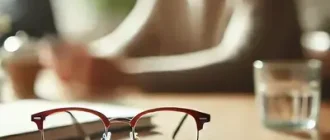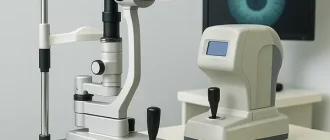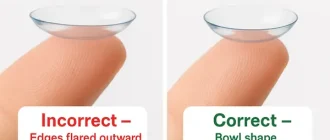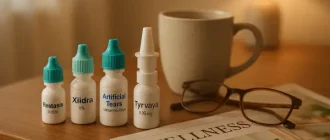The blue range of the light spectrum has a special effect on the human body. With the development of technology, the amount of blue radiation entering our eyes has increased significantly. In particular, the blue light effect on eyes causes great concern among ophthalmologists. In its excess, negative processes develop: biorhythms are disturbed, retinal degeneration occurs, and various pathologies arise. Why does this happen?
From the definition in the physics textbook, we know that light – is electromagnetic radiation propagated in waves. Our visual organs are only able to detect them in the small visible range from 380 to 760 nanometers. Radiation below 380 nm is called ultraviolet and above 760 nm infrared. Both of these spectra are not directly visible to our eyes. Blue light is the common name for violet wavelengths of 380-420 nm and blue wavelengths of 420-500 nm. Blue light poses a serious hazard when administered to the eye in large quantities. Dissipated in the eye structures, it provokes visual impairment, affects image quality when looking into the distance.
Common sources of blue light
Solar radiation is a natural source of blue light, it is impossible to hide from it. But people protect their eyes with sunglasses. Today, experts are sounding the alarm on a different subject. The biggest danger is posed by common sources of blue light, such as energy-saving lamps and LCD screens of all kinds of gadgets.
These things are all around us. Warm-burning light bulbs are being replaced by energy-saving bulbs everywhere, and people sometimes spend a lot of time with their phones and tablets during the day. Negative radiation from their screens is up to 40% more than from the sun. And the closer the gadget is to the face, the more intense the blue light affects the eyes.
What is the effect of blue light on the eyes
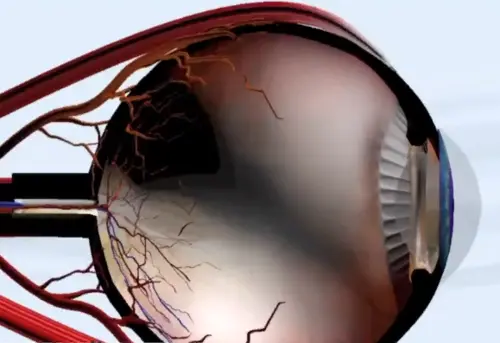
Scientists have been studying the effects of shortwave light on our visual organs for decades. As a result of serious research, it was found that prolonged exposure to blue light adversely affects the health of the eyes, and provokes a number of dangerous pathologies, and not only ophthalmic.
In many scientific papers noted the fact that blue light entering the eye in large excess, leads to the destruction of the retina. It causes a photochemical reaction, resulting in increased production of dangerous free radicals. It is these particles that have a damaging effect on the photoreceptors responsible for the quality of vision. Free radicals accumulate in the retina, causing it to degenerate.
The degree of absorption of blue light depends on the age of the person. It is most intense in children: for example, the eyes of a 10-12 year old child are almost ten times more vulnerable to blue light than the eyes of a 90 year old man. Adults have better protection because their crystalline lens is less transparent. Besides children, the risk group includes people who work in rooms with bright fluorescent lights for a long time, as well as those who have had surgery to replace the natural lens with an intraocular lens.
What is the harm of blue light for biorhythms
Circadian rhythms are the most important process in human life. They are also called the “internal clock.” In other words, it is the alternation of periods of sleep and wakefulness during the day. The biological clock tunes our body to certain changes depending on the time. These are natural processes, but artificial light directly affects their work.
The fact that the special photoreceptors, located in the eyes, send a signal to the epiphysis: it is responsible for the synthesis and release into the blood of the hormone melatonin, which is responsible for sleep. When darkness falls, its production increases, contributing to sleepiness. Prolonged exposure to blue light suppresses the production of melatonin, shifting circadian rhythms by an average of three hours, so there is no desire to fall asleep in time. Remember the nightly vigils in front of the computer, when you don’t want to sleep at all.
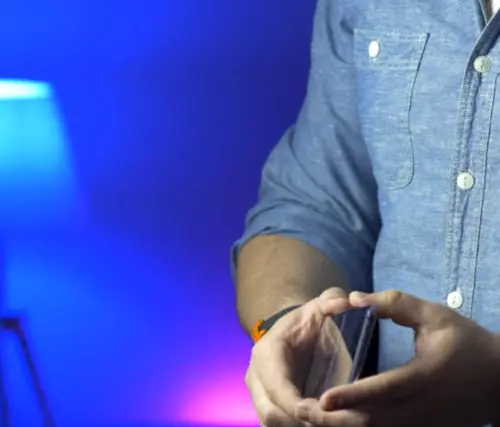
In 2013, a study was published proving that even half an hour in a room with bright fluorescent lights is enough to disrupt normal melatonin production in an adult. That’s why healthy sleep problems are so often diagnosed in modern people. The pervasive effects of blue light from lamps and gadgets are a direct cause.
Harvard scientists conducted the following experiment. Ten volunteers were artificially shifted circadian rhythms by blue light for several months. Then they had tests taken from them and found that the blood sugar levels of 8 participants were significantly elevated to pre-diabetes. Conversely, the concentration of leptin, the hormone responsible for satiety, decreased. This means that a person with impaired biorhythms and normal sleep experiences feelings of hunger even with normal biological satiety. Thus, obesity and diabetes are the likely outcomes of increased exposure to blue light.
How to protect your eyes from the harmful rays of blue light
Today, many people are underinformed about the effects of blue light on the eyes. Both adults and children need to follow protective measures to protect themselves from its negative effects. Here are a few recommendations from experts on how to protect your eyes from excessive blue radiation:
- Reduce the number of hours a day spent with gadgets and in front of a computer. You should especially try to avoid using digital devices with glowing screens in the evening hours, when melatonin production increases, the body is preparing for sleep. If that is not possible, you should use protective glasses with yellow lenses that block blue radiation.
- In the bedroom, it is better not to use energy-saving lamps. Bright cold lighting will be appropriate in the kitchen, in the bathroom, contributing to a more active awakening, and in the bedroom it is better to have a lamp with warm light. People with age-related macular dystrophy are better off avoiding bright fluorescent lights altogether.
- At least two hours before going to sleep it is better to give up the use of digital devices with LED screens.
- Children and adolescents should be outside for at least three hours a day. The action of blue light from a natural source of radiation contributes to the development of proper biorhythms. In addition, outdoor movement games provide visual activity at different distances, improving the accommodation of the eyes. If children need to spend long periods of time in front of a computer, it is better to use glasses with lenses that contain a filter that blocks blue light.
New technologies to help regulate the amount of blue radiation
Getting people to give up the habit of spending time with gadgets is very difficult, especially children and teenagers. In addition, bright lights are all around us: it is the lighting of public spaces – shopping malls, sports facilities airports, catering facilities and so on. Nowadays in the world most people work long hours in front of a computer getting a massive dose of blue light on their eyes. That is why it is very difficult to eliminate the pervasive influence of blue radiation. However, scientists are constantly offering ways to help reduce its impact on the organs of vision. For example, there are glasses with amber-colored glasses that help improve sleep.
An experiment was conducted with a group of volunteers suffering from insomnia. Seven people received glasses with ordinary glass lenses and seven more received glasses with special lenses of rich amber color. Each group of participants wore them two hours before sleep for a week. Then they swapped glasses for another week and continued to do the same for the next seven days.
The results of this small study indicated that the participants who used the amber-colored optics averaged half an hour more sleep, and that the amount of time they fell asleep was reduced. They confirmed that the quality of sleep improved, and signs of insomnia almost disappeared during the use of the device. Specialists believe that the yellow glasses are an affordable way to combat insomnia, especially when combined with other protective measures. It has also been previously proven that yellow lenses have an effect on reducing blood pressure, and this also disposes to sleep. Gadget manufacturers are introducing a function to turn on yellow light at night in new models, but for computers or televisions such a feature is not available.

